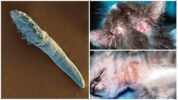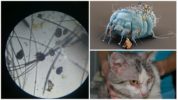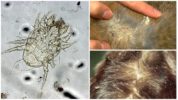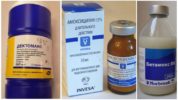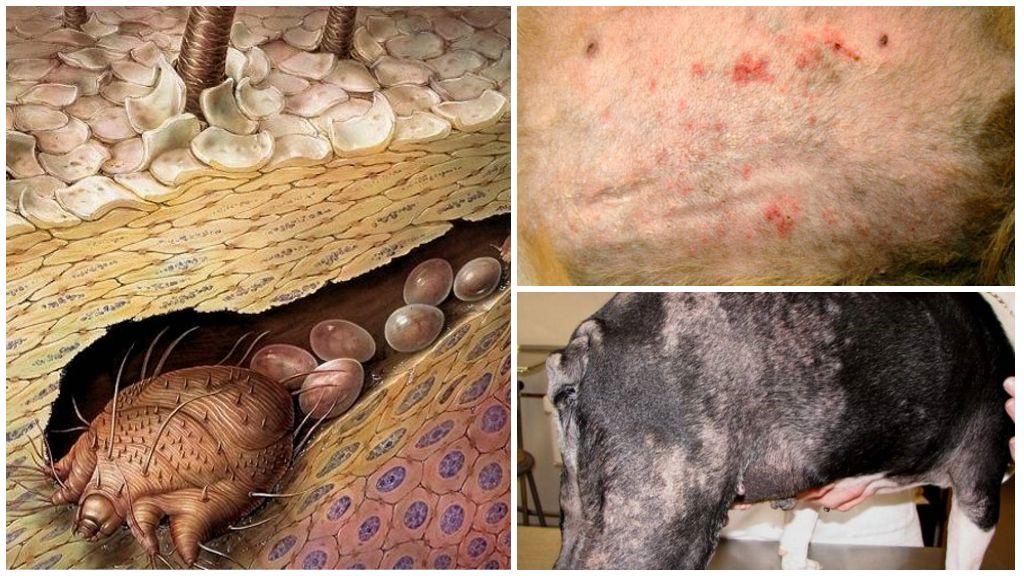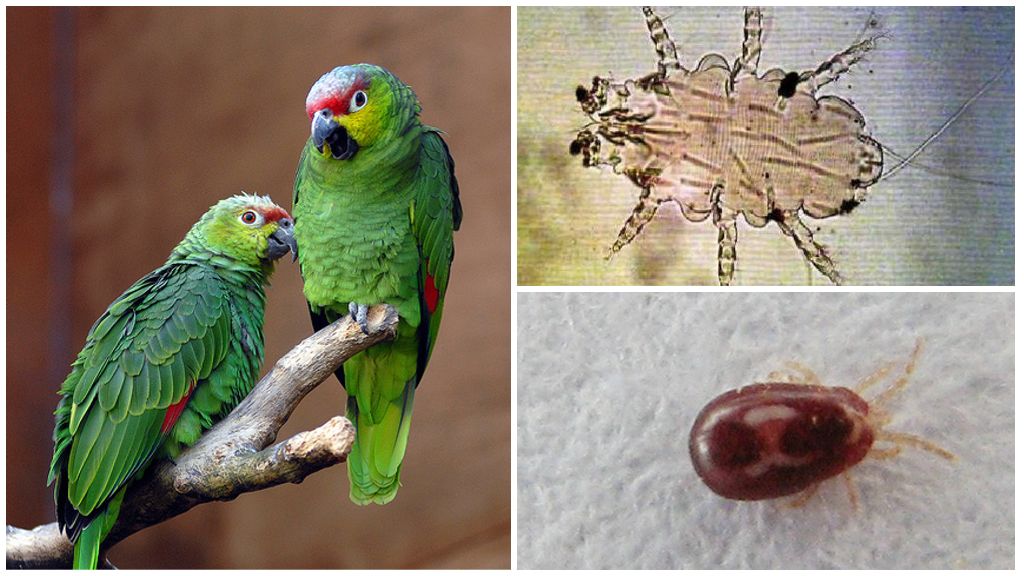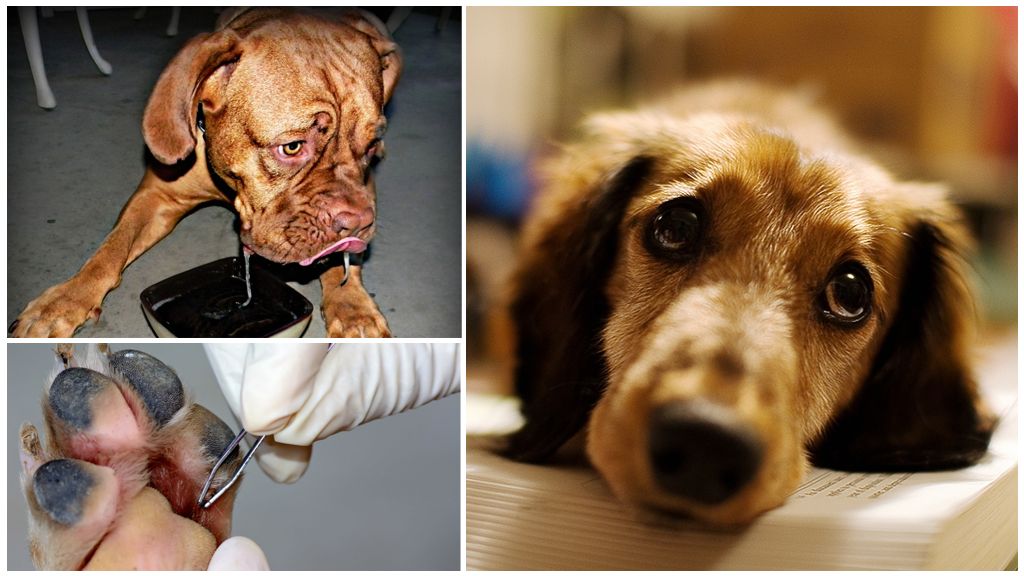- Demodex in cats
- Sarcoptosis in animals
- Notoedrosis, itchy scabies in cats
- Hayletiellosis
- Thrombiculosis in cats
- Subcutaneous tick treatment
The subcutaneous tick in cats causes itching, irritation, redness, damage to the epidermis. The concept combines several parasites that live in the layers of the skin. Symptoms of a subcutaneous tick in cats are similar to other dermatological diseases, to find out the root cause you need to consult a veterinarian.
Types of subcutaneous ticks in cats
Several parasites can inhabit the dermis in animals.
Demodex
A microscopic creature cannot be seen with the naked eye. Lives demodex tick under the skin, localized in the hair follicles, sebaceous ducts. It is conditionally pathogenic, since it begins to harm the cat in certain circumstances.
Demodex lives on the skin of cats, dogs, people, all animals, birds. It feeds on secretions of fat, thereby healing the body. With a weakening of immunity, a violation of metabolic processes, food for the tick becomes poor-quality. This leads to the fact that the tick releases a toxic substance, and after a few days it dies. It is the process of decomposition of dead demodexes that causes negative consequences in cats, cats.
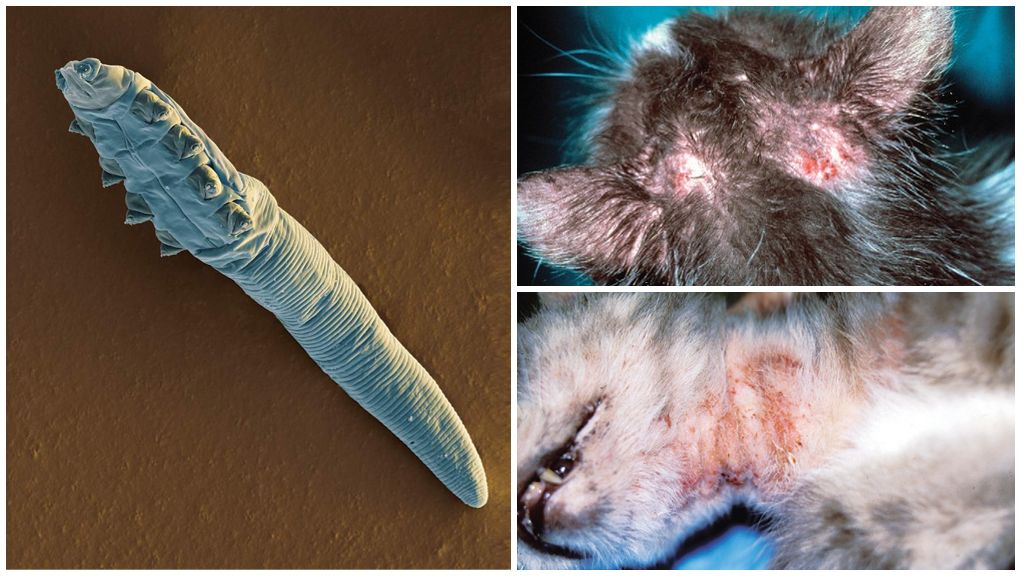
On a note!
Main symptoms demodicosis in cats: itching, skin irritation, redness, hair loss. But this disease occurs only in young, weakened cats. The disease is more susceptible to dogs, people. To cure the disease, it is necessary to strengthen the immune system.
Sarcoptes scabiei
A small subcutaneous parasite causes sarcoptosis. It has symptoms identical with demodicosis, the only difference is that it proceeds more clearly. On the skin appears irritation, itching, redness, baldness, as well as pustules, sores, cracks, which is a distinctive feature.
Sarcoptes scabiei is able to dwell under the skin of cats for years without causing negative symptoms, but this is not the norm, the parasite must be destroyed, the pet must be treated. It is sarcoptosis that makes cats constantly scratch their ears, tear the skin. The subcutaneous tick provokes severe itching, which forces the pet to itch. At the site of the lesion, bald patches, keratinized areas, rough skin appear.
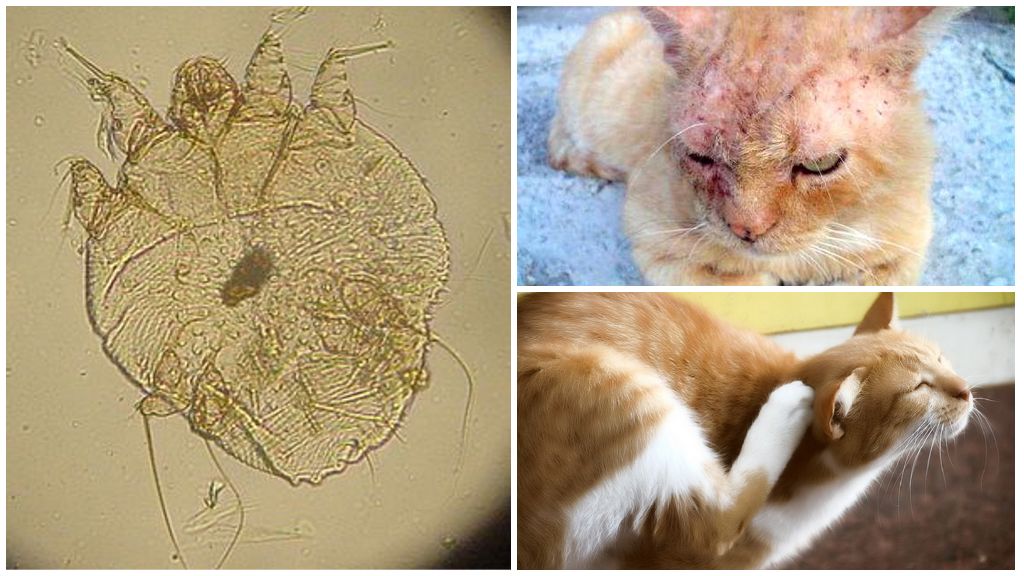
Important!
In chronic sarcoptosis, the skin of cats is covered with scars, scars, tubercles, age spots. In the affected areas does not grow wool. To diagnose the disease take scraping. With a positive result, prolonged treatment is prescribed.
Notoedrosis
It differs from previous brothers in larger sizes. A photo of the subcutaneous tick in cats of this species is presented below. It provokes a dangerous disease - notahedrosis. It completely affects the entire skin, the whole body of the cat. Danger to other animals, humans, transmitted by contact.
The primary symptoms of notaedrosis are typical: itching, irritation, redness, inflammation, peeling, hair loss. Outside the body of the animal, the tick is able to live for about 25 days at a temperature within 22 degrees Celsius. What does a subcutaneous tick look like, can be seen through a magnifying glass, it is impossible to detect a parasite with the naked eye.
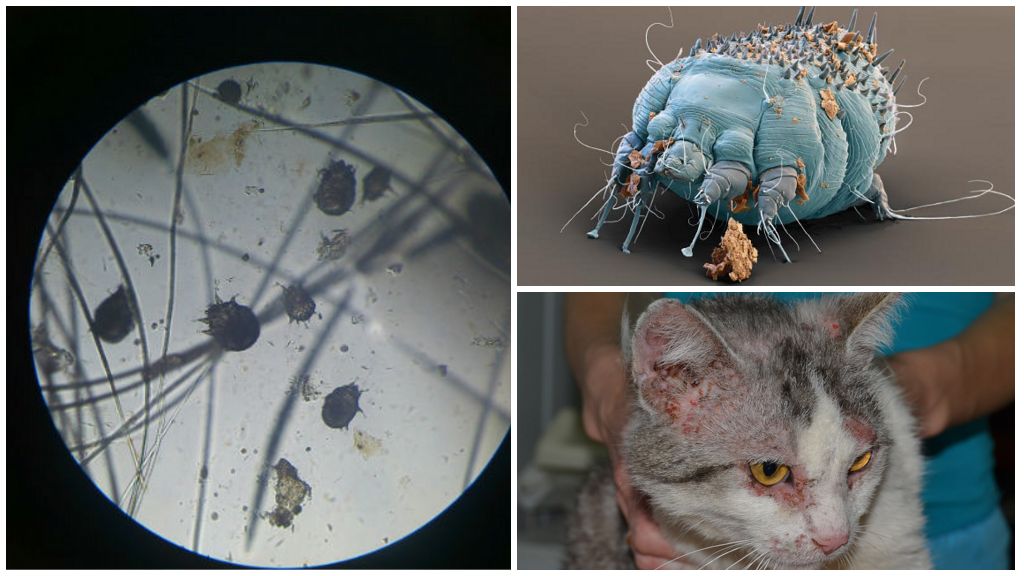
On a note!
Noothedrosis is transmitted to humans from cats, but lives on the human body for no more than 30 days. Causes slight itching, redness, peeling of the epidermis. The development of the young generation of parasites under human skin is impossible.
Cheyletiella
A small subcutaneous tick provokes a dermatological disease - cheyletiellosis. transmitted by contact from a sick animal. Infectious to humans, tubercles similar to mosquito bites occur at the site of the lesion. Itching is present for several days.
The subcutaneous tick of this species does not affect the deep layers of the epidermis, focuses in the upper. It is localized in certain places, in most cases - the back. At the site of the lesion, severe peeling occurs, the coat falls off, turns red, and the skin is irritated. A subcutaneous tick in a kitten can cause an additional severe allergy.
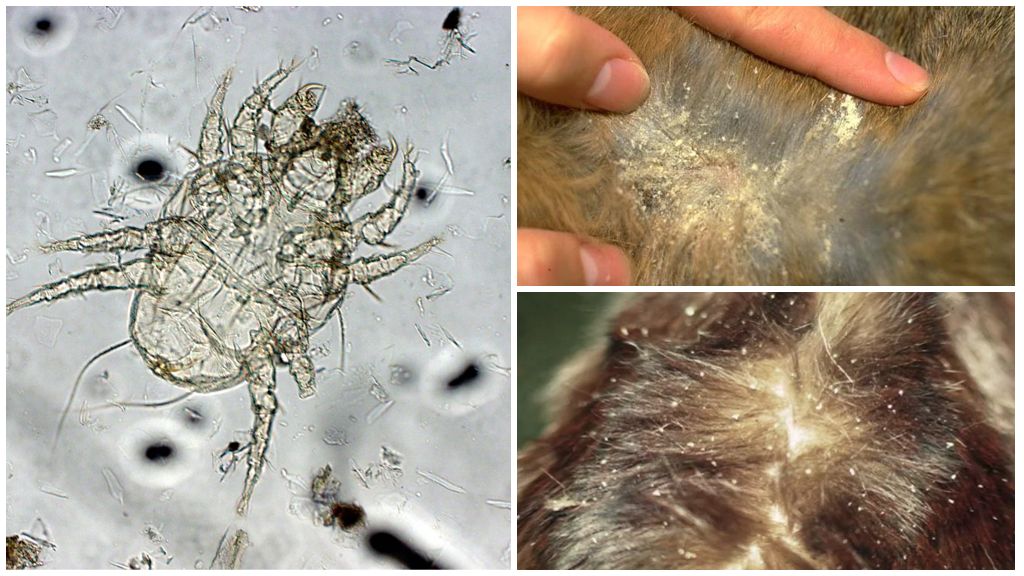
Diagnosed easily. The material for the study is the affected epidermis, scraping is done in the veterinarian’s office. Treatment at home is short-lived, with a favorable outcome.
Trombiculidae
Universal, very tenacious parasites. Thrombiculosis provokes. They live in the earth, on the body, under the skin of animals, birds, insects. They are kept in groups, sexually mature, young individuals live together. Affect the skin focal. The first symptoms of infection appear on the mucous membranes of the lips, nose, eyes, anus.
Adult individuals reach a size of 0.5 mm, you can see ticks under a microscope. A specialist can diagnose the disease when examining a cat. The body of the subcutaneous tick is soft, reddish in color. The photo is presented below. A tubercle, itching, redness, burning appears on the skin. If you press on a group of subcutaneous ticks, a bloody trail remains.
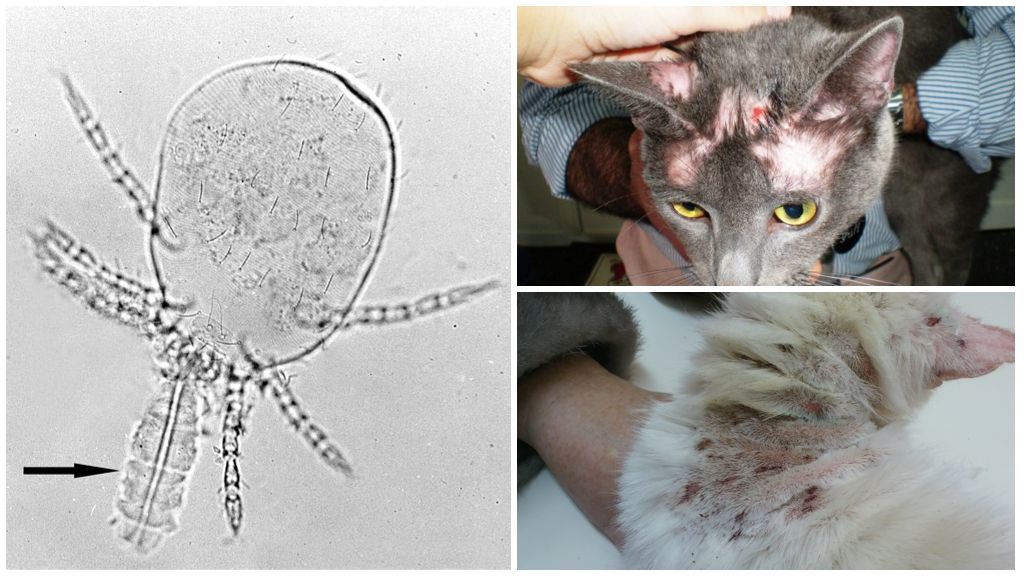
Symptoms and treatment
For the treatment of subcutaneous ticks, there are special drugs that destroy parasites at different stages of development. The most effective means are drops, injections. Valid for 3-6 months, destroy the entire colony of subcutaneous ticks.
Important!
To cure a cat completely, it is necessary to use means to accelerate the recovery of the epidermis, strengthen immunity. If the body remains weakened, the mites will again begin to parasitize.
Treatment of subcutaneous tick in cats is carried out by several means.
- Initially, at home, you need to buy a pet with a special shampoo - Elite with chlorhekidine, Doctor with benzoyl peroxide.
- The affected areas are treated with chlorhexidine or hydrogen peroxide to get rid of crusts, scabs, purulent accumulations.
- On the skin of a cat in the shoulder area drops lawyer, Stronghold. After a month, the treatment is repeated, so 4 times. Butox 50, Amitraz are also used.
For the treatment of subcutaneous ticks in cats, Citealu is used. The drug helps get rid of crusts. The epidermis is treated up to 4 times per day. After treating the pet after 5 minutes, it must be rinsed, dried. Then apply a medicine for a subcutaneous tick:
- Aversectin ointment;
- Amidel gel;
- Ivermek gel;
- Liniment Demos;
- Sulfur ointment.
It is recommended to apply oil solutions to areas with fallen wool: Amit, Tsipam, Ektodes, Mykodemotsid.
Other products in the form of ointment, spray:
- Perol;
- Acaromectin;
- Ivermek
- We are waiting;
- Neo-stopping.
In parallel, they give drugs to strengthen the immune system:
- Maksidin;
- Gamavit;
- Gala Vet;
- Immunol
- Ligfol;
- Immunoparasitan
It is necessary to treat a subcutaneous tick comprehensively. It is necessary to provide the cat with proper nutrition and drink. Give non-carbonated mineral water.
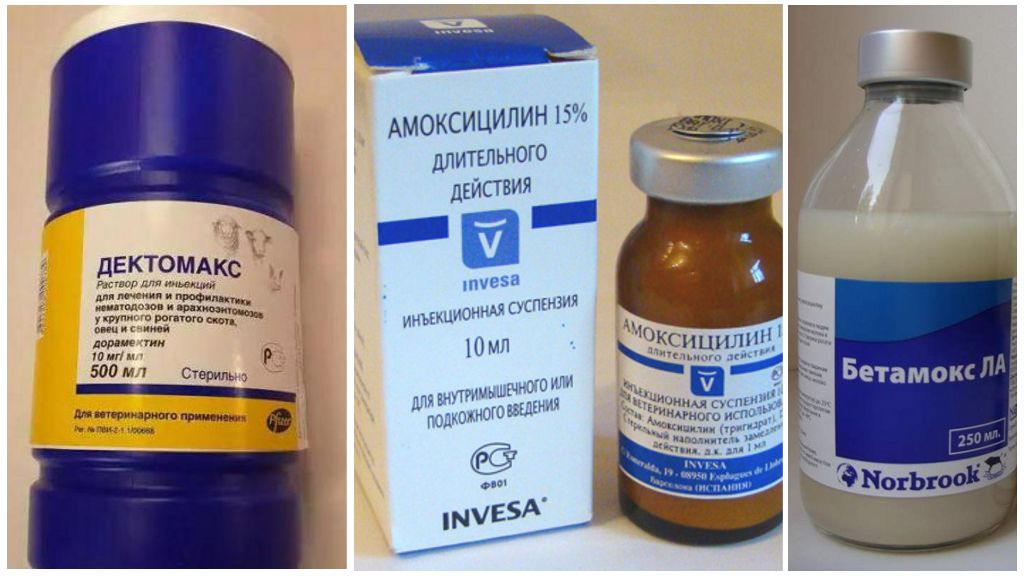
In severe cases, injections from a subcutaneous parasite are made. Assign Zidectin in a dose of 0.4 ml at a time or Dectomax - the dose is calculated based on the weight of the pet. When a secondary infection is attached, broad-spectrum antibiotics are prescribed:
- Amoxicillin;
- Betamox;
- Baytril;
- Kanamycin.
Important!
Comprehensive treatment should be prescribed by a specialist.The condition of the animal is normalized in the first days of therapy.
Folk remedies
It is recommended to apply in cases where it is not possible to purchase a special drug. Folk remedies are not highly effective, dry the skin, cause allergies.
- The cat is soaped with soap, which includes birch tar. Wrap with cling film, after 5-10 minutes, bathe the animal. Repeat the procedure several times with a break of 2-3 days.
- The areas of the skin with the fallen wool are lubricated with kerosene. After 3 days, the pet is bathed. If necessary, repeat the treatment again.
- To speed up the recovery of the epidermis, tincture of calendula and a decoction of chamomile are used. Wipe 2-3 times a day.
In the absence of a therapeutic effect, the cat should be shown to the veterinarian within 7 days. If an allergy appears against the background of alternative treatment, stop treatment immediately.
